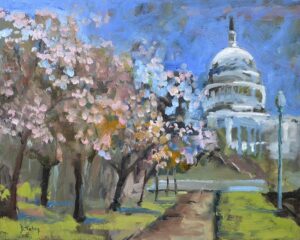As we await the weekend and close out another crazy-ass work week, here’s a normal, yet abnormal item (due to climate change), reflecting on nature’s annual flower show in DC. Yet this is better than shit news concerning our situation surmounting everything, everywhere, all at once; consider it a respite to the nowadays.
Instead, peak bloom:
Washington’s cherry blossoms are in peak bloom https://t.co/NB9r6uJora
— Post Local (@postlocal) March 23, 2023
Summary of the 2023 version via The Washington Post yesterday:
Meredith Brown, 25, drove roughly four hours from Raleigh, N.C., to see the trees begin to bloom. She visited the Tidal Basin on Monday with a group of friends and took pictures. There weren’t a lot of people around, and the sky was clear. Most trees weren’t in peak bloom yet, but the sight was “wonderland-esque,” she said.
“I feel like we lucked out,” Brown said. She added that she plans to see the trees again another year.
The National Cherry Blossom Festival started Monday in coordination with the flowering of the cherry blossoms. It will run until April 16 with more than 30 events, which include a grand opening ceremony on Saturday, a kite festival on Sunday and a parade in April.
The excitement over the flowering trees has been clear all over town. Dozens of restaurants have announced cherry-blossom-centric special menu items, and some D.C. Metro cars and buses are covered in cherry blossom decals.
The peak bloom date of March 23 is tied with 1946 and 1976 as the ninth earliest in records that date back to 1921.
Because of climate change and rising temperatures, the average peak bloom date has advanced from April 5 to March 31 since the 1920s.
The earliest peak bloom on record occurred on March 15, 1990, and the latest on April 18, 1958.
Peak bloom has occurred before March 31 in each of the previous four years; last year’s peak bloom was on March 21, the eighth earliest on record.
The cherry blossom buds sped through their initial stages of development this year boosted by abnormally warm temperatures in February and early March. Their progress was slowed by chillier weather in mid-March, but the return of sunshine and mild weather in recent days pushed them to Thursday’s peak.
This year’s peak bloom comes within the March 22-25 window predicted by the National Park Service. It is earlier than the Capital Weather Gang’s initial projection for March 25-29 but within its revised window of March 19-23.
On Saturday, the blossoms were at Stage 5 — known as “puffy white” — meaning most flowers were about to open up.
Quaint, considering the horror of the DC times. And everywhere — from Gizmodo earlier today:
If it wasn’t obvious, climate change is likely to blame. Washington D.C. has warmed by more than 2 degrees Fahrenheit on average over the last 100 years, according to the EPA. Those still-rising temperatures encourage trees to bud and blossom ever-sooner. And it’s not just happening in D.C..
Recent years have demonstrated that Kyoto, Japan’s blossoms are shifting time tables, too, also thanks to climate change. In 2021, Kyoto’s trees experienced their earliest peak bloom in 1,200 years of record-keeping.
If you think about it too much, climate change altering the timing of cherry blossoms could get depressing. After all, fossil fuel companies’ ceaseless drive to pump greenhouse gases into the atmosphere is impacting a whole lot more than just ornamental trees.
These types of plant shifts have troubling ecosystem and agricultural implications. What if, for instance, a plant regularly starts to bloom before its pollinators emerge? What if increasingly erratic weather brings out blossoms early but then a freeze follows—killing a wild plants’ chance at reproducing in a given year?
Plus, as climate change progresses, cherry blossom trees (and other plants) could end up more susceptible to disease. In the nation’s capital, specifically, sea level rise caused by climate change also poses a threat to some of the beloved trees, which are planted around D.C.’s Tidal Basin.
If humanity doesn’t make big changes soon, cherry blossom trees and a whole lot more could be at risk. But why focus on any of that, when you could just look at these nice flowers?
Blooming among the dooming, or not, once again here we are…
 (Illustration out front: ‘Cherry Tree Blossoms in Washington DC,’ acrylic print, by Donna Tuten, and found here.)
(Illustration out front: ‘Cherry Tree Blossoms in Washington DC,’ acrylic print, by Donna Tuten, and found here.)